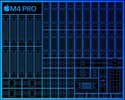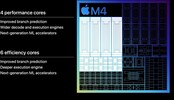Apple M4 Pro (14 cores) vs Apple M4 (10 cores)
Apple M4 Pro (14 cores)
► remove from comparison
The 14-core Apple M4 Pro is a powerful ARM architecture processor (SoC) for laptops and mini-PCs that debuted in Sep 2024. It features 10 performance CPU cores running at up to 4.5 GHz along with 4 efficient cores running at up to 2.6 GHz. The 20-core M4 GPU and at least 24 GB of fast 273 GB/s LPDDR5x on-package memory depending on the configuration are included as well, as is USB 4 and Thunderbolt 5 support.
The built-in 16 core neural engine (up to 38 TOPS) is found across the whole M4 chip family. Furthermore, all M4 processors are thought to be based on the ARM v9.4-A architecture to a certain degree.
Performance
In our testing, the M4 Pro delivered multi-thread benchmark scores very close to those of the 16-core M3 Max as well as the Intel Core i9-12950HX. Some small generation-to-generation improvement is obviously present but it's the new integrated graphics adapters that are the real stars of the show.
Graphics
The 20-core M4 GPU has hardware support for ray tracing as well as mesh shading and other modern technologies. It supports external displays with resolutions as high as "8K" and it can HW-decode a few popular video codecs such as h.264, h.265 and AV1.
Its gaming performance is at least as good as that of the GTX 1660 Ti Laptop. Please keep in mind that very few games have been compiled specifically for Apple silicon Macs meaning most titles have to be run via emulation layers. Some of them are displayed with visual artefacts as a result, or don't start at all.
- The Witcher 3 1080p Ultra = 53 fps (close to the GTX 1660 Ti Laptop)
- Baldur's Gate 3 1440p Ultra = 42 fps (close to the GeForce RTX 4050 Laptop)
- Cyberpunk 2077 2.1 Phantom Liberty 1080p Ultra = 40 fps (close to the GTX 1660 Ti Laptop)
Power consumption
When under heavy CPU and GPU load, the SoC briefly consumes around 80 W before settling at around 70 W later. With no load at all, it makes do with 2 W to 7 W. A single P-core of the chip eats around 6 W when under heavy load.
The 2nd generation 3 nm TSMC process the M4 Pro is built with delivers good power efficiency, as of late 2024.
Apple M4 (10 cores)
► remove from comparison
The 10-core Apple M4 is an impressively fast ARM architecture processor (SoC) sporting 4 performance and 6 efficient CPU cores along with a 16-core neural engine and a 10-core GPU with hardware RT support and other modern features. On-package 7500 MT/s LPDDR5x RAM, USB 4 support and Thunderbolt 4 support are onboard as well, as are Wi-Fi 6E and Bluetooth 5.3.
The M4 debuted in May 2024 as part of an iPad launch event; its 4 performance cores run at up to 4.4 GHz, representing a healthy improvement over the M3 (10-core GPU) and its 4.06 GHz top clock speed. Besides, this new chip also has 6 efficient cores at its disposal that run at up to 2.9 GHz. The M3 had to make do with 4 performance cores and 4 efficient cores, for reference.
Architecture and Features
The new CPU cores run at faster clock speeds than what the M3 was capable of while also featuring some minor architectural improvements. A heavily customized version of ARM's v9.4-A microarchitecture is reportedly employed here. The M4 comes with on-package LPDDR5x-7500 RAM (120 GB/s) whereas the M3 was limited to 6400 MT/s. The updated NPU delivers up to 38 TOPS of performance for AI workloads.
Performance
In 2024 iPad Pros, the 3 nm chip is 10% to 20% faster than the M3 (10 GPU cores) in both multi-thread and single-thread short-term workloads. It also delivers about 10% higher multi-thread performance than the 9-core M4. This puts the 10-core part on an equal footing with the Ryzen 7 7745HX, Core i7-13705H and other higher-end x86 processors released in 2023 and 2024.
iPad Pros come with no active cooling solution however Mac minis and MacBook Pros do have one and the latest iMacs probably do as well. As our Fall 2024 Mac mini review shows, the M4's short-term performance doesn't benefit much from the presence of a fan, however its sustained performance benefits tremendously.
Graphics
The M4 GPU (10 cores) has hardware support for ray tracing as well as mesh shading and other modern technologies. It supports external displays with resolutions as high as 8K.
The graphics adapter runs at higher clock speeds than what the (otherwise identical) 10-core GPU built into the 9-core M4 can muster. As our Mac mini 2024 review confirmed, its performance is good enough to run many 2023 and 2024 games at 1080p on low or medium quality settings.
- Сyberpunk 2077 2.1 Phantom Liberty (1080p, Med): 28 fps
Much like it is with CPU performance, M4-powered iPad Pros will be much slower in long-term GPU-intensive workloads than iMacs, Mac minis and MacBook Pros due to the lack of proper cooling.
Power consumption
This specific M4 chip is found in 2024 iPad Pros, 2024 iMacs, 2024 Mac minis and 2024 MacBook Pros. Within the thin metal cases of the iPads - no active cooling - the chip's sustained power consumption hovers in the 4 W - 5 W area, with short-term peaks of up to 14 W possible. However, Mac minis and MacBook Pros do have an active cooling solution (and the new iMacs probably do, too) meaning the power consumption figures are several times higher. In our Fall 2024 Mac mini review, the SoC consumed 30 W to 40 W when under high loads.
The M4 is built with a "second generation" 3 nm TSMC process which is still cutting-edge as of late 2024.
| Model | Apple M4 Pro (14 cores) | Apple M4 (10 cores) | ||||||||||||||||||||||||||||||||||||||||||||||||||||||||
| Series | Apple M4 | Apple M4 | ||||||||||||||||||||||||||||||||||||||||||||||||||||||||
| Series: M4 |
|
| ||||||||||||||||||||||||||||||||||||||||||||||||||||||||
| Clock | 2592 - 4512 MHz | 2890 - 4464 MHz | ||||||||||||||||||||||||||||||||||||||||||||||||||||||||
| L2 Cache | 4 MB | 4 MB | ||||||||||||||||||||||||||||||||||||||||||||||||||||||||
| Cores / Threads | 14 / 14 10 x 4.5 GHz Apple M4 P-Core 4 x 2.6 GHz Apple M4 E-Core | 10 / 10 4 x 4.5 GHz Apple M4 P-Core 6 x 2.9 GHz Apple M4 E-Core | ||||||||||||||||||||||||||||||||||||||||||||||||||||||||
| TDP | 40 Watt | 40 Watt | ||||||||||||||||||||||||||||||||||||||||||||||||||||||||
| TDP Turbo PL2 | 46 Watt | 40 Watt | ||||||||||||||||||||||||||||||||||||||||||||||||||||||||
| Technology | 3 nm | 3 nm | ||||||||||||||||||||||||||||||||||||||||||||||||||||||||
| Features | Unified Memory LPDDR5X-8533 (273 GB/s), 16-Core Neural Engine, Media Engine (Encoding / Decoding: H.264, HEVC, ProRes, ProRes RAW, AV1 Decoding only) | Unified Memory LPDDR5X-7500 (120 GB/s), 16-Core Neural Engine, Media Engine (Encoding / Decoding: H.264, HEVC, ProRes, ProRes RAW, AV1 Decoding only) | ||||||||||||||||||||||||||||||||||||||||||||||||||||||||
| iGPU | Apple M4 Pro 20-Core GPU | Apple M4 10-core GPU | ||||||||||||||||||||||||||||||||||||||||||||||||||||||||
| NPU / AI | 38 TOPS INT8 | |||||||||||||||||||||||||||||||||||||||||||||||||||||||||
| Architecture | ARM | ARM | ||||||||||||||||||||||||||||||||||||||||||||||||||||||||
| Announced | ||||||||||||||||||||||||||||||||||||||||||||||||||||||||||
| Manufacturer | www.apple.com | |||||||||||||||||||||||||||||||||||||||||||||||||||||||||
| Transistors | 28 Million |
Benchmarks
Average Benchmarks Apple M4 Pro (14 cores) → 100% n=12
Average Benchmarks Apple M4 (10 cores) → 84% n=12
* Smaller numbers mean a higher performance
1 This benchmark is not used for the average calculation













